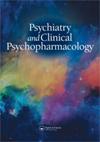Establishing the cut-off scores for the severity ranges of schizophrenia on the BPRS-6 scale: findings from the REAP-AP
IF 0.6
4区 医学
Q4 PHARMACOLOGY & PHARMACY
引用次数: 2
Abstract
ABSTRACT Objective: Using data from the Research on Asian Psychotropic Prescription Patterns for Antipsychotics (REAP-AP), our study aimed to establish the remission and severity ranges (mild, moderate, and severe) of schizophrenia on the Brief Psychiatric Rating Scale-6 (BPRS-6). Methods: A total of 1,438 patients with schizophrenia from India, Indonesia, Japan, Malaysia, and Taiwan were enrolled in the study. Using the receiver operating characteristic (ROC) curve analyses, the optimal cut-off scores for the remission and severity ranges on the BPRS-6 were established. Results: The scalability of the BPRS-6 was considered to have an acceptable “unidimensionality” (coefficient of scalability = 0.43). The cut-off scores for the remission of schizophrenia and mild, moderate, and severe schizophrenia can be optimally defined as the BPRS-6 total score of <5, 5–9, 10–19 and >20, respectively. Conclusion: The BPRS-6 can be a promising, brief, and unidimensional rating scale to supplement the measurement-based care of schizophrenia.在BPRS-6量表上建立精神分裂症严重程度范围的截止分数:来自REAP-AP的发现
摘要目的:利用《亚洲抗精神病药物处方模式研究》(REAP-AP)的数据,本研究旨在通过《简明精神病学评定量表-6》(BPRS-6)建立精神分裂症的缓解和严重程度范围(轻度、中度和重度)。方法:共纳入来自印度、印度尼西亚、日本、马来西亚和台湾的1438例精神分裂症患者。采用受试者工作特征(ROC)曲线分析,建立BPRS-6缓解和严重程度范围的最佳分值。结果:BPRS-6的可扩展性具有可接受的“单维性”(可扩展性系数= 0.43)。精神分裂症缓解和轻度、中度、重度精神分裂症的分界点分别为BPRS-6总分20分。结论:BPRS-6量表是一种简洁、单维的精神分裂症量表,可作为精神分裂症计量护理的补充。
本文章由计算机程序翻译,如有差异,请以英文原文为准。
求助全文
约1分钟内获得全文
求助全文
来源期刊

Psychiatry and Clinical Psychopharmacology
Medicine-Psychiatry and Mental Health
CiteScore
1.00
自引率
14.30%
发文量
0
期刊介绍:
Psychiatry and Clinical Psychopharmacology aims to reach a national and international audience and will accept submissions from authors worldwide. It gives high priority to original studies of interest to clinicians and scientists in applied and basic neurosciences and related disciplines. Psychiatry and Clinical Psychopharmacology publishes high quality research targeted to specialists, residents and scientists in psychiatry, psychology, neurology, pharmacology, molecular biology, genetics, physiology, neurochemistry, and related sciences.
 求助内容:
求助内容: 应助结果提醒方式:
应助结果提醒方式:


